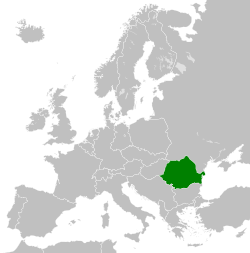Romanian People's Republic
| Socialist Republic of Romania | ||||||||||
| Republica Socialistă România | ||||||||||
|
||||||||||
|
||||||||||
|
Motto Proletari din toate țările, uniți-vă! (English: Proletarians of all countries, unite!) |
||||||||||
|
Anthem Zdrobite cătușe (1947–1953) Te slăvim Românie (1953–1977) Trei culori (1977–1990) |
||||||||||
| Capital | Bucharest | |||||||||
| Languages | Romanian | |||||||||
| Government | Unitary Marxist-Leninist one-party totalitarian dictatorship | |||||||||
| General Secretary | ||||||||||
| • | 1944–1954, 1955–1965 | Gheorghe Gheorghiu-Dej | ||||||||
| • | 1954–1955 | Gheorghe Apostol | ||||||||
| • | 1965–1989 | Nicolae Ceaușescu | ||||||||
| President | ||||||||||
| • | 1947–1952 (first) | Constantin Parhon | ||||||||
| • | 1967–1989 (last) | Nicolae Ceaușescu | ||||||||
| President of the Council of Ministers | ||||||||||
| • | 1947–1952 (first) | Petru Groza | ||||||||
| • | 1982–1989 (last) | Constantin Dăscălescu | ||||||||
| Legislature | Great National Assembly | |||||||||
| Historical era | Cold War | |||||||||
| • | Monarchy abolished | 30 December 1947 | ||||||||
| • | New constitution adopted | 13 April 1948 | ||||||||
| • | New constitution adopted | 24 September 1952 | ||||||||
| • | New constitution adopted | 21 August 1965 | ||||||||
| • | Fall of Ceaușescu | 22 December 1989 | ||||||||
| Area | ||||||||||
| • | 1987 | 238,391 km² (92,043 sq mi) | ||||||||
| Population | ||||||||||
| • | 1987 est. | 23,102,000 | ||||||||
| Density | 96.9 /km² (251 /sq mi) | |||||||||
| Currency | Leu | |||||||||
| Calling code | +40 | |||||||||
|
||||||||||
| Today part of |
|
|||||||||
|
a. Started 1971.
The administrative divisions of the country were județe from 1947 to 1950, rayons from 1950 to 1968 and județe from 1968 to 1989. |
||||||||||
The Socialist Republic of Romania (Romanian: Republica Socialistă România, RSR) refers to Romania under Marxist-Leninist one-party Communist rule that existed officially from 1947 to 1989. From 1947 to 1965, the state was known as the Romanian People's Republic (Republica Populară Romînă, RPR). The country was a Soviet-aligned Eastern Bloc state with a dominant role for the Romanian Communist Party enshrined in .
As World War II ended, Romania, a former Axis member, was occupied by the Soviet Union, the sole representative of the Allied powers. On 6 March 1945, after mass demonstrations by communist sympathizers and political pressure from the Soviet representative of the Allied Control Commission, a new pro-Soviet government that included members of the previously outlawed Romanian Communist Party was installed. Gradually, more members of the Communist Party and communist-aligned parties gained control of the administration and pre-war political leaders were steadily eliminated from political life. In December 1947, King Michael was induced to abdicate and the People's Republic of Romania was declared.
At first, Romania's scarce post-war resources were drained by the "SovRoms", new tax-exempt Soviet-Romanian companies that allowed the Soviet Union to control Romania's major sources of income. Another drain was the war reparations paid to the Soviet Union. In the 1950s, however, Romania's communist government began to assert more independence, inducing, for example, the withdrawal of all Soviet troops from Romania by 1958.
...
Wikipedia



